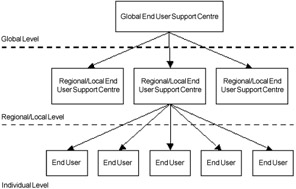End User Management Issues
|
|
The end users are the ultimate group of people using the global information systems on a regular basis. The task of managing and supporting end user groups is not only in maintaining business information operations but is the key to evaluating and improving the global information systems. The fundamental concerns of the end user management category in globalization context (Lan, 2002) include managing end user computing facilities, end user computing education, introducing and learning new global information systems, help desk support, and end user involvement in global information systems development as mentioned in the "Information Systems Effectiveness" section.
Managing End User Computing Facilities
Controlling the end user computing equipments and facilities is a complex assignment especially in the global organization where business units are dispersed across nations. Managing end user computing facilities should be taken into account when planning and designing the global information systems. Tasks involved in the end user facilities management may include the identification of facilities in each business units and subsidiaries, verification of facilities availability, development of standard maintenance procedures, and the development of standard facility purchasing, logistic and distribution procedures.
End User Computing Education
In the modern business environment, employees' capability of using computers to perform business tasks seems to be part of the job requirements. The basic computing skills such as producing documents, sending e-mails, and browsing the Internet are required in most office environments. However, the level of employees' computing education in the global organization varies from subsidiary to subsidiary. Thus, there is a need to incorporate end user computing education plan in the global transition process. The main objective of the plan is to ensure that the employees' have obtained required computing skills in all business units. It may consist of the identification of the employees' current computing skills and levels, identification of essential computing skills development of training programs, and implementation of training programs.
Introducing and Learning New Global Information Systems
When the development of global information systems reaches a certain level (such as the testing and deploying stages), the training programs should be introduced. The training programs should be developed through the systems development teams and the human resources department collaboratively. In order to develop the appropriate training programs for the respectable end users, the initial stage is the mapping of the organizational hierarchy in terms of the end user types and responsibilities to the systems functionality.
Help Desk Support
As per many other business information systems, help desk plays a key role in keeping the users satisfied of performing business tasks through the global information systems. To provide an effective help desk service, two fundamental concepts may be incorporated in the help desk function - a clear understanding of what are the services the users anticipate, and accurately and timelessly responding of problems reported by users. Figure 6 illustrates a proposed a help desk structure to accommodate the global information systems help services. It includes a centralized global end user support center and various regional or local end user support centers. The global end user support center takes care of problems and requests dealing with transborder activities in global context and manages the regional/local end user support centers. In the regional/local centers, the main services are to firstly define the scope of request (global or regional/local) and secondly provide help on issues relating to local or regional activities. If the problem relates to the transborder activities, the regional/local center will divert the request to the global end user support center for resolution.

Figure 6: Global help desk structure
End User Involvement in Global Information Systems Development
Users' perception and information requirements drive the entire development of global information systems effort (Laudon and Laudon, 2002). Users must have sufficient control over the design and development of global information systems to ensure that business functions and operations are accurately incorporated. Moreover, the design of global information systems should be based on all stakeholders. In other words, lack of users involvement in the design of global information systems is the major cause of systems failure.
There are always benefits by involving users on information systems development teams. However, it is even more important to engage users in global information systems development. As mentioned above, users are people who understand the business functions and operations. Involving various type of users through the entire global information system analysis and design phases is crucial as it helps in making sure the global information system would appropriately implement business processes and bring extra value to the business. It is also believed that users who have been involved in the design and development phases would become change agents for the introduction of new systems. The change agents play the role of disseminating the concept of new systems to members in their local business unit and who may be involved in developing training programs.
|
|
EAN: 2147483647
Pages: 224